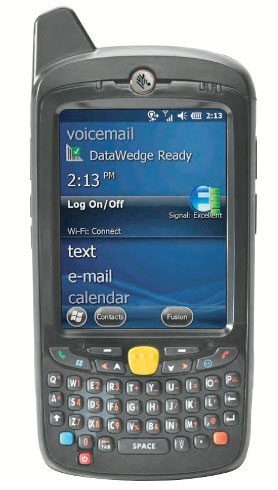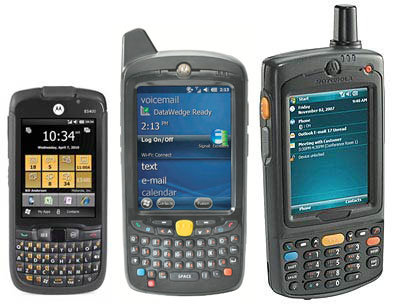|
Zebra MC67 Mobile Computer
Quick and very tough mid-range "Enterprise Digital Assistant" for the field workforce
(by Conrad H. Blickenstorfer)
Motorola Solutions, the enterprise division of which is now part of Zebra, introduced the MC67 "Enterprise Digital Assistant" or "EDA" in September 2013 as a technological update, complement and successor to the company's MC65.  The MC67 combines the functionality of a cell phone, a bar code scanner, a camera, a walkie talkie and a mobile computer all into one small and handy device. The MC67 combines the functionality of a cell phone, a bar code scanner, a camera, a walkie talkie and a mobile computer all into one small and handy device.
The MC67 is a significant technological step forward to the midrange of a line of ruggedized PDAs that started way back when Motorola's Symbol Technologies first had the foresight to offer an industrial, scanner-equipped version of the then enormously popular Palm III in 1998 or so. From that emerged a class of small enterprise handheld computers geared towards communications and data capture requirements of mobile workers that grew into today's lineup of Motorola Enterprise Digital Assistants and mobile computers. They currently include the small MC40, the MC45, the MC55, the new MC67 that seems to replace it, and the top-of-the-line MC75:

Above: Motorola's Enterprise Digital Assistants ES400, MC67, and MC75
In this lineup, the MC67 is for task worker applications in the field such as parcel collection and delivery scanning, inventory management, sales order entry, direct store delivery and route accounting.
In terms of looks and design, the MC67 looks the same as the MC65, but looks deceive a bit as the MC67 is faster, tougher, better sealed and has more features.
So let's take a look at what all the MC67 offers:
While most users will never notice anything other than its faster operation compared to the MC65, it's interesting that Motorola switched from a 600MHz MSM Qualcomm 7627 CPU to a 1GHz TI OMAP 4 with integrated PowerVR SGX540 graphics. That's a chip that can run both Windows Mobile and Android.
The HC67 runs Microsoft Embedded Handheld 6.5 Professional, onboard RAM has quadrupled to 1GB, and onboard Flash is no 8GB compared to the MC65's 1GB. There's an micro-SD Card slot that supports cards up to 32GB. There's integrated 802.11a/b/g/n WiFi and Class II Bluetooth 2.1 + EDR, and the MC67 has an 8mp auto-focus integrated camera with external flash.
In terms of size and weight, the MC67 remains the same as the MC65, which means it still only measures about 6.5 x 3.1 inches and is just 1.3 inches thick. Weight is about 13.5 ounces. That means that the MC67 is quite a bit larger and heavier than standard consumer smartphones, but it still fits into most pockets. The touchscreen display measures 3.5 inches diagonally and has a strong 650+ nits backlight. It offers 480 x 640 VGA resolution, which works nicely with this size display.
In terms of ruggedness, the MC65 was far tougher than any commercial market PDA, and the MC67 is a bit tougher yet. It can handle 8-foot drops instead of six, is sealed to IP65 and IP67 specifications instead of the MC65's IP65. In IP67 sealing, the "6" means the device completely sealed against any dust intrusion, and the "7" that it is even protected against complete immersion. The operating temperature range is an even wider -4 to 122 degrees Fahrenheit. Motorola also quotes a "tumble spec" where the devices survive a thousand 1.6 foot tumbles.
Wireless communication standards evolve quickly, and the MC67 takes advantage of that. With a dual wireless WAN modem, users can either use 4G GSM or 3.5G CDMA, and activate either just one or both. The MC65 also supports autonomous and assisted GPS.
As almost all Motorola Solutions devices, the MC67 is well equipped for data capture. It comes with the powerful Symbol SE4500 imager that can handle any 1D and 2D barcode and decoding task. So now customers just need to decide if they want a device with just the SE4500 imager (the SR, DL, and DPM/HD versions are available), or one that includes the 8mp auto-focus camera with its user-controllable flash as well.
For power, the MC67 comes standard with the 3.7V/3,600mAH Li-Ion battery that was only available as an "extended" option on earlier MC models.
As was the case with the MC65, the MC67 is meant to fill the gap between business-class consumer PDAs and industrial devices, only with even more emphasis on toughness and performance. As such, the MC67 is a cross-over product that's both handy and rugged, serves as an advanced data capture device, offers robust voice and data communication, and now even frees users from being limited to whatever cellular provider is in their area.
|



